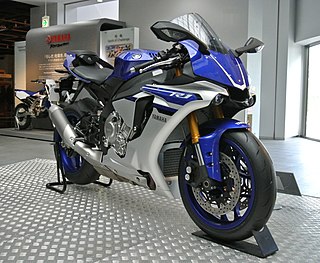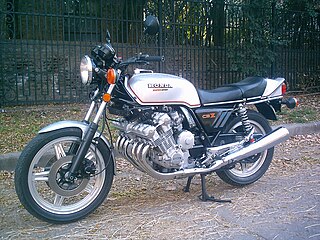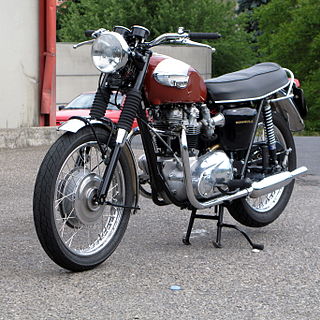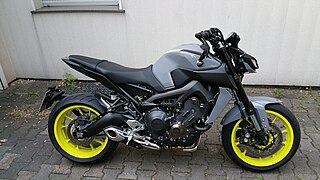
A straight-three engine is a three-cylinder piston engine where cylinders are arranged in a line along a common crankshaft.

The Yamaha YZF-R1, or simply R1, is a 998 cc (60.9 cu in) sports motorcycle made by Yamaha. It was first released in 1998, undergoing significant updates in 2000, 2002, 2004, 2006, 2007, 2009, 2015, 2018 and 2020.

A sport bike, sports motorcycle, or sports bike is a motorcycle designed and optimized for speed, acceleration, braking, and cornering on asphalt concrete race tracks and roads. They are mainly designed for performance at the expense of comfort, fuel economy, safety, noise reduction and storage in comparison with other motorcycles.

The Honda CBX sports motorcycle was manufactured by Honda from 1978 to 1982. With a 1047cc inline six-cylinder engine producing 105 bhp (78 kW), it was the flagship of the Honda range. The CBX was well-received by the press, but was outsold by its sibling introduced in late 1979, the Honda CB900F.

Vincent Motorcycles was a British manufacturer of motorcycles from 1928 to 1955. The business was established by Philip Vincent who bought an existing manufacturing name HRD, initially renaming it as Vincent HRD, producing his own motorcycles as HRD did previously with engines purchased as complete assemblies from other companies. From 1934, two new engines were developed as single cylinder in 500 cc and v-twin 1,000 cc capacities. Production grew from 1936, with the most-famous models being developed from the original designs after the War period in the late 1940s.
Roadog is a motorcycle built by engineer and motorcycle enthusiast Wild Bill Gelbke between 1962 and 1965. A total of two were built. Gelbke, who had attended engineering school in Wisconsin and at University of Southern California, had worked for McDonnell Douglas and also owned two motorcycle shops in Chicago and Hammond, Indiana. He wanted to create a motorcycle that was dependable and was able to cruise at highway speeds comfortably for long periods. Gelbe constructed and welded the frame himself using 4130 chrome-molybdenum tubing, and equipped the machine with a Chevrolet 153 engine and GM powerglide transmission. The shaft drive was constructed from a Chevrolet 1-ton truck differential that was cut in half. The complete bike is 17 feet (520 cm) long and weighs 3,280 pounds (1,490 kg). Its great size and weight make the bike impossible for most people to steer until it is moving at a speed of at least 15 miles per hour (24 km/h), and when at rest it is held up by hydraulic rams that are deployed by the driver.
LML was an Indian scooter and motorcycle manufacturer formerly based in Kanpur, Uttar Pradesh.

Associated Motor Cycles (AMC) was a British motorcycle manufacturer founded by the Collier brothers as a parent company for the Matchless and AJS motorcycle companies. It later absorbed Francis-Barnett, James, and Norton before incorporation into Norton-Villiers. Henry Herbert Collier founded Matchless as a cycle company in 1878. His sons Henry (Harry) and Charles (Charlie) joined him and the name was changed to H. Collier & Sons.

The featherbed frame was a motorcycle frame invented by the McCandless brothers and offered to the British Norton motorcycle company to improve the performance of their racing motorcycles in 1950. It was considered revolutionary at the time, and the best handling frame that a racer could have. Later adopted for Norton production motorcycles, it was also widely used by builders of custom hybrids such as the Triton, becoming legendary and remaining influential to this day.

The Triumph Bonneville T120 is a motorcycle originally made by Triumph Engineering from 1959 to 1975. It was the first model of the Bonneville series, which was continued by Triumph Motorcycles Ltd. The T120 was discontinued in favour of the larger 750 cc T140 in the early 1970s.

The Dunstall Norton was a Norton motorcycle made by Paul Dunstall, a specialist tuner of the 1960s and early 1970s twins originally using some parts from Norton's Domiracer project when the Birmingham factory was closed in 1963. In 1966 Dunstall Motorcycles became a motorcycle manufacturer in its own right so that Dunstalls could compete in production races, and set a number of world records before sales of the Dunstall Nortons declined in the 1970s consistent with the demise of the British motor cycle industry and a corresponding rise in Japanese imports.

The Harley-Davidson XR-750 is a racing motorcycle made by Harley-Davidson since 1970, primarily for dirt track racing, but also for road racing in the XRTT variant. The XR-750 was designed in response to a 1969 change in AMA Grand National Championship rules that leveled the playing field for makes other than Harley-Davidson, allowing Japanese and British motorcycles to outperform the previously dominant Harley-Davidson KR race bike. The XR-750 went on to win the most races in the history of American Motorcyclist Association (AMA) racing.

The Kawasaki H1 Mach III was a two-stroke 500 cc sport bike made by Kawasaki from 1969 through to 1975.

Colin Jordan Seeley was a British motorcycle retailer who later became a motorcycle sidecar racer, motorcycle designer, constructor and retailer of accessories. In 1992 he was involved in running the Norton Rotary race team.

The Yamaha MT-09 is a street motorcycle of the MT series with an 847–890 cc (51.7–54.3 cu in) liquid-cooled four-stroke 12-valve DOHC inline-three engine with crossplane crankshaft and a lightweight cast alloy frame. For 2018, the bike is now designated MT-09 in all markets.
William "Wild Bill" Gelbke was an American engineer and motorcycle designer. He is noted for having designed and constructed large motorcycles powered by automobile engines, particularly the Roadog and the Auto Four, the latter a motorcycle intended for mass production. Roadog was intended to be featured on an episode of The History Channel's Modern Marvels, however the bit was cut from the episode.
Walneck's Classic Cycle Trader was a motorcycle magazine begun in 1978 by motorcycle enthusiasts and swap meet organizers Buzz and Pixie Walneck. The first issues were flyers that listed motorcycle parts for sale; demand for parts and complete motorcycles subsequently resulted in the publication growing into a large, full color magazine that contained over 120 pages during its peak. In 1997 the Walnecks sold the magazine to Trader Publishing, which enabled international distribution. In 2012, it was sold again to Causey Enterprises LLC, who redesigned the magazine extensively, however ceased publishing in 2014. The magazine was established and originally headquartered in Woodridge, Illinois before it was sold to Norfolk, Virginia-based Trader Publishing.

The Ducati 250 Mark 3 is a 249 cc (15.2 cu in) single cylinder bevel drive SOHC motorcycle produced by the Italian manufacturer Ducati from 1967 to 1974. Initially produced using the 'narrow case' engine, the newly introduced 'wide case' engine was used from 1968. A higher performance version, the Ducati 250 Mark 3D, which used desmodromic valves was also available.
The Ducati Monza is a 249 cc (15.2 cu in) single cylinder bevel drive SOHC motorcycle produced by the Italian manufacturer Ducati from 1961 to 1968. It was the touring version of Ducati's first 250 cc road bike. Reviews of the Monza praised its speed, road holding, engine smoothness and brakes.

The Benelli 650 Tornado is a 650 cc (40 cu in) parallel twin motorcycle produced by the Italian manufacturer Benelli from 1970 to 1975. The model was intended to compete with the British big twins in the lucrative American Market but by the time the model was introduced the market had changed following the launch of multi-cylinder bikes by the Japanese manufacturers, most notably the Honda CB750. The Tornado was also badge engineered as a Motobi, Benelli's sister company. Around 3,000 Tornados were produced with half being sold in Italy.















